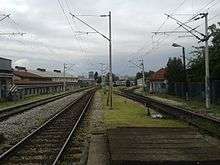Zagreb train disaster
 Monument to victims of the train accident at the Mirogoj Cemetery work of Vojin Bakić | |
| Date | August 30, 1974 |
|---|---|
| Time | 22:40 |
| Location | Zagreb |
| Coordinates | 45°48′18″N 15°59′18″E / 45.80490°N 15.98840°ECoordinates: 45°48′18″N 15°59′18″E / 45.80490°N 15.98840°E |
| Country | Yugoslavia |
| Rail line | Belgrade-Dortmund |
| Operator | Yugoslav Railways |
| Type of incident | Derailment |
| Cause | Excessive speed |
| Statistics | |
| Trains | 1 |
| Passengers | 400 |
| Deaths | 153 |
| Injuries | 60 |
The Zagreb train disaster occurred on August 30, 1974, when an express train (number 10410)[1] traveling from Belgrade to Dortmund derailed before entering Zagreb Main Station (then in Socialist Federal Republic of Yugoslavia, present-day Croatia), killing 153 people.[2][3] It was the worst rail accident in the country’s history to that date and remains one of the worst in Europe’s history. Many of the passengers died immediately, as many as 41 of whom could not be identified and were buried in a common grave at the Mirogoj Cemetery.[4]
The accident occurred when all nine cars from a passenger express train derailed and rolled over at the entrance to Zagreb's main train station, at 719 meter from the entrance to the track IIa. At 22:33 hours the locomotive on the track IIa station went alone.[5]
The passengers found were mainly gastarbeiters from Germany and their families, including a lot of children. The driver and assistant remained unharmed, and the locomotive intact. The locomotive is now on display in the Croatian Railway Museum.[4]
The train was arriving into Zagreb from Vinkovci at 19.45 local time. The driver, Nikola Knežević and his assistant Stjepan Varga, were both exhausted, both of them having worked for two full days.[4]


A subsequent investigation into the accident showed that the train at several sites exceeded the speed limit by nearly 70 kilometers per hour, so that instead of entering the station at the speed limit of 40 km/h, the engine driver rushed in with a speed of 104 km/h. They also began to hit the brakes too late, so that the train derailed and soon became an unrecognizable wreck.[1][6]
The driver was sentenced to 15 years imprisonment, and his assistant to 8 years. The court upheld their fatigue due to spending 52 hours working as a mitigating circumstance.[4][5]
The surviving passengers reported that the train had not slowed down while passing through the stations at Ludina and Novoselec, about an hour before reaching Zagreb Main Station, and that it had leaned dangerously.[4]
References
- 1 2 Batinica, Mila (21 December 2009). "Prije 35 godina 150 mrtvih na kolodvoru - Jutarnji.hr" (in Croatian). Jutarnji list. Retrieved 9 February 2014.
- ↑ Handabaka, Antonija (15 February 2010). "Najveće željezničke nesreće: U Zagrebu je poginulo 153 ljudi - Jutarnji.hr" (in Croatian). Jutarnji list. Retrieved 9 February 2014.
- ↑ ""Zagrebačka noć užasa": Obilježava se godišnjica stravične željezničke nesreće na Glavnom kolodvoru - Vijesti.net - Index.hr" (in Croatian). Index.hr. 2012-08-30. Retrieved 9 February 2014.
- 1 2 3 4 5 "Najveća željeznička nesreća u hrvatskoj povijesti - Crna kronika - Hrvatska" (in Croatian). Dalje.com. 2009-07-24. Retrieved 28 February 2011.
- 1 2 "30. kolovoza 1974. noć užasa na zagrebačkom Glavnom kolodvoru - Jutarnji.hr". Reconstruction of the head of the Croatian Railway Museum Helena Bunijevac and curator Denis Marohnić. (in Croatian). Jutarnji list. 2 September 2006. Retrieved 9 February 2014.
- ↑ "Najtragičnija željeznička nesreća u čitavoj hrvatskoj povijesti - 1974." (in Croatian). Dnevno.hr. 2012-08-30. Retrieved 9 February 2014.
External links
- This Day in History 1974: Train crashes into station in Yugoslavia (History Channel)
- Danger Ahead! Zagreb 1974